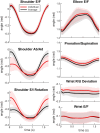This is a preprint.
Evaluating Joint Angle Data for Clinical Assessment Using Multidimensional Inverse Kinematics with Average Segment Morphometry
- PMID: 39282382
- PMCID: PMC11398373
- DOI: 10.1101/2024.09.03.611088
Evaluating Joint Angle Data for Clinical Assessment Using Multidimensional Inverse Kinematics with Average Segment Morphometry
Abstract
Movement analysis is a critical tool in understanding and addressing various disabilities associated with movement deficits. By analyzing movement patterns, healthcare professionals can identify the root causes of these alterations, which is essential for preventing, diagnosing, and rehabilitating a broad spectrum of medical conditions, disabilities, and injuries. With the advent of affordable motion capture technologies, quantitative data on patient movement is more accessible to clinicians, enhancing the quality of care. Nonetheless, it is crucial that these technologies undergo rigorous validation to ensure their accuracy in collecting and monitoring patient movements, particularly for remote healthcare services where direct patient observation is not possible. In this study, motion capture technology was used to track upper extremity movements during a reaching task presented in virtual reality. Kinematic data was then calculated for each participant using a scaled dynamic inertial model. The goal was to evaluate the accuracy of joint angle calculations using inverse kinematics from motion capture relative to the typical movement redundancy. Shoulder, elbow, radioulnar, and wrist joint angles were calculated with models scaled using either direct measurements of each individual's arm segment lengths or those lengths were calculated from individual height using published average proportions. The errors in joint angle trajectories calculated using the two methods of model scaling were compared to the inter-trial variability of those trajectories. The variance of this error was primarily within the normal range of variability between repetitions of the same movements. This suggests that arm joint angles can be inferred with good enough accuracy from motion capture data and individual height to be useful for the clinical assessment of motor deficits.
Keywords: Disabilities; Dynamic inertial model; Model scaling; Motion capture technology; Motor deficits; Movement analysis; Movement redundancy; Quantitative data; Rehabilitation; Remote healthcare; Upper extremity movements; Virtual reality.
Conflict of interest statement
Competing Interests The authors declare no competing interests.
Figures



Similar articles
-
The influence of proximal motor strategies on pianists' upper-limb movement variability.Hum Mov Sci. 2023 Aug;90:103110. doi: 10.1016/j.humov.2023.103110. Epub 2023 Jun 7. Hum Mov Sci. 2023. PMID: 37295318
-
Muscle torques and joint accelerations provide more sensitive measures of poststroke movement deficits than joint angles.J Neurophysiol. 2021 Aug 1;126(2):591-606. doi: 10.1152/jn.00149.2021. Epub 2021 Jun 30. J Neurophysiol. 2021. PMID: 34191634 Free PMC article.
-
A neural tracking and motor control approach to improve rehabilitation of upper limb movements.J Neuroeng Rehabil. 2008 Feb 5;5:5. doi: 10.1186/1743-0003-5-5. J Neuroeng Rehabil. 2008. PMID: 18251996 Free PMC article.
-
Characterization of normative angular joint kinematics during two functional upper limb tasks.Gait Posture. 2019 Mar;69:176-186. doi: 10.1016/j.gaitpost.2019.01.037. Epub 2019 Jan 28. Gait Posture. 2019. PMID: 30769260
-
Upper limb kinematics after cervical spinal cord injury: a review.J Neuroeng Rehabil. 2015 Jan 30;12:9. doi: 10.1186/1743-0003-12-9. J Neuroeng Rehabil. 2015. PMID: 25637224 Free PMC article. Review.
References
-
- Franklyn-Miller A, Richter C, King E, Gore S, Moran K, Strike S, et al. Athletic groin pain (part 2): a prospective cohort study on the biomechanical evaluation of change of direction identifies three clusters of movement patterns. Br J Sports Med. 2017;51: 460–468. doi:10.1136/bjsports-2016-096050 - DOI - PMC - PubMed
-
- King E, Franklyn-Miller A, Richter C, O’Reilly E, Doolan M, Moran K, et al. Clinical and biomechanical outcomes of rehabilitation targeting intersegmental control in athletic groin pain: prospective cohort of 205 patients. Br J Sports Med. 2018;52: 1054–1062. doi:10.1136/bjsports-2016-097089 - DOI - PMC - PubMed
Publication types
Grants and funding
LinkOut - more resources
Full Text Sources
